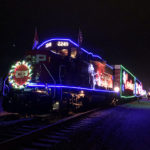Home »

CME’s glancing blow brings northern lights
I took these photos of the northern lights from the College of the Rockies in Cranbrook at 11:30 p.m. on Tuesday night, Sept 4. Most of the northern horizon was glowing, reaching 40 degrees high in the sky. Even in town with streetlights and the moon shining from the East, the aurora was still glowing bright. Here in the photos you can see curtains of dominant greens with pale reds spiking above. The pine trees below are lit sodium-yellow by the streetlights. Stars are visible through the glow; you can see the end of the big dipper in the photo at upper left.
 Fascinating to watch the motion, 30 seconds later: the big spike falls and merges into an S band:
Fascinating to watch the motion, 30 seconds later: the big spike falls and merges into an S band:
Again, 30 seconds later it spreads out:
Just to show the scale, this last photo is looking northeast, over towards Lakit Mountain seen at the bottom right corner (Fort Steele way). I’m using the camera lens set on wide angle 28mm f/3.3, and I’m just using a short eight second exposure time at 3200 ISO.
The College meteor camera recorded the aurora Monday night also, but not as bright. It’s rare that it’s this bright in Cranbrook. Wayne Sanders in Prince George also reports the northern lights events were recorded on his meteor camera.
The dim red glow at the top of the curtain occurs above 200km, when fast moving electrons hit low-pressure oxygen atoms in the atmosphere. The middle green is from glowing oxygen molecules between 100 and 200km. Below 100km, nitrogen atoms will glow a dim purplish colour. Below that, the air pressure is too high and no effect is seen.
What caused it? According to NOAA, an August 31 a solar prominent flare shot a coronal mass ejection towards the Earth. When the first part arrived on Sept. 1, a glancing blow from the charged cloud resulted in 10MeV protons hitting our upper atmosphere, growing to a max on Sept. 2 at 2:50 a.m. Mountain time and fading away Sept 4 at 12:25 a.m. That energy stirred up the Earth’s current geomagnetic storms and aurora borealis.
They say that Earth’s polar magnetic field remains stormy and unsettled two days after the coronal mass ejection (CME) impact of Sept. 3. A moderately strong geomagnetic storm is underway now at high latitudes, sparking bright auroras all around the Arctic Circle that should last for the 5th and 6th of September.
The sun has been unusually quiet the past years; the last sunspot max was in 2001. But in the next few years we should see more frequent northern lights events, since the sun is finally moving towards a sunspot maximum, now predicted for spring of 2013.








